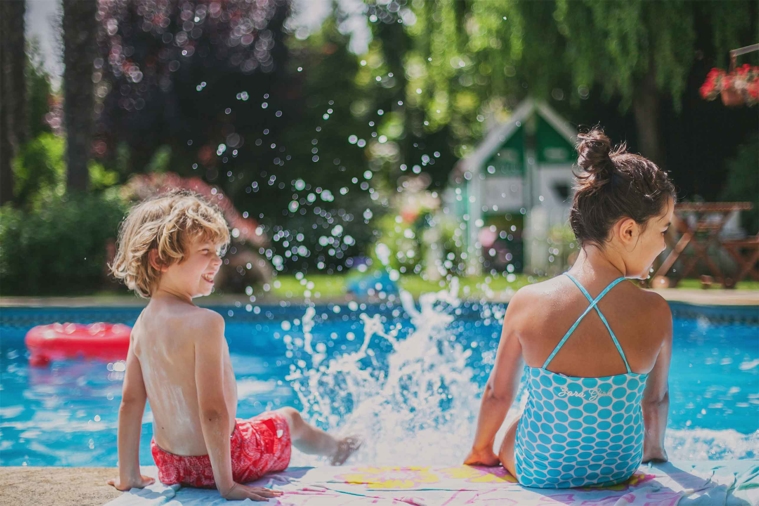Skin Conditions You Can Get at the Pool
May 11, 2023

Protect yourself and your family from these potential problems so you can swim, soak and splash the summer away.
In warmer weather, your family is probably ready to make a splash in the pool or slide into the local water park. But these wet environments can be covered with bacteria and chemicals that cause unwanted skin conditions.
That doesn’t mean a day at the pool, beach or lake is out of the question. Here, we share tips on four common conditions, including how to identify them, how to avoid them and how they are treated.
What Is Folliculitis?
If you notice pimple-like bumps on your skin after spending time in a hot tub or pool, you might have an infection known as hot tub folliculitis. This condition occurs when hair follicles become infected after exposure to bacteria found in warm, wet environments.
Experts estimate that the bacteria that causes this condition is present in more than half of all hot tubs and pools. To avoid developing folliculitis, shower with soap immediately after spending time in the water and wash your bathing suit after each use.
Folliculitis Signs and Symptoms
Hot tub folliculitis generally starts as a rash of small red bumps on the skin, which develop 12 to 48 hours after hot tub or pool use. As the infection develops, the bumps may become tender and fill with pus. These spots tend to occur in areas where your swimsuit covers your body and holds water against your skin.
How to Treat Folliculitis
Folliculitis should resolve on its own within five to 10 days. If you experience discomfort, apply a warm compress to the affected area 15-20 minutes at a time, three to four times a day.
If the infection lasts longer than 10 days or comes back, talk to your primary care provider, who may recommend a topical antibiotic to clear it up.
Read More: Five Water Safety Tips for Summer
What Is Cellulitis?
Cellulitis is a skin infection that can occur when an open wound comes in contact with bacteria found in wet environments, including pools, rivers and lakes. You might be at higher risk of contracting cellulitis if you have any of the following conditions, which can allow bacteria to get through your skin’s protective layer more easily:
- Athlete’s foot
- Eczema
- Chickenpox or shingles
- Chronic edema, or swelling of the limbs
If you have any of these conditions, have an open wound or an unhealed tattoo or piercing, or use injection drugs, avoid submerging the affected area in water until it has healed. Clean wounds and wash hands frequently to avoid the spread of bacteria.
Cellulitis Signs and Symptoms
Cellulitis begins with red, swollen, warm skin around the wound site. As it develops, you might experience additional symptoms, including:
- Tenderness or pain
- Blisters
- Fever
- Chills
How to Treat Cellulitis
As cellulitis develops, it can spread to other parts of the body and cause additional complications, including infections of the blood, bones or joints, or swelling of the heart. If you suspect you have cellulitis, talk to your primary care provider. A course of antibiotics can often clear up the condition within seven to 10 days.
What Is Impetigo?
If your child experiences itchy yellow scabs or blisters after a day at the pool, it might be a case of impetigo. This highly contagious bacterial infection is easily spread through close contact, and the bacteria that causes it can thrive in damp towels.
This infection is most common in children ages 2 to 5, though older children and adults can get it, too.
Impetigo Signs and Symptoms
The first signs can appear around 10 days after exposure to the bacteria that causes impetigo. The infection occurs in two stages: First, red, itchy, fluid-filled sores open around the exposure site. A few days later, yellow crusts form over the sores. These scabs heal over two to three weeks — sooner if you seek treatment from a provider — and usually do not leave a scar.
How to Treat Impetigo
Because impetigo is very contagious, Adventist Health providers recommend seeking treatment to shorten the duration of the infection and decrease transmission. Your child’s pediatrician can prescribe oral or topical antibiotics.
You can also take the following steps to reduce symptoms and lessen the likelihood of the infection spreading:
- Do not share towels.
- Avoid touching or picking at the scabs or sores.
- Clean the affected skin with antibacterial soap and water.
- Practice regular hand-washing and encourage your children to do the same.
- Wash towels and clothing at a high temperature.
What Is Chlorine Rash?
Chlorine is a chemical used in pools and hot tubs to kill germs and bacteria that can cause many of the skin conditions covered above. Overexposure to this irritant, however, can result in a mild chemical burn called chlorine rash.
To prevent this rash, shower immediately after getting out of the pool and don’t swim too often or for long periods. Avoid overly chlorinated pools, as the high concentration of the chemical can increase the chances of experiencing chlorine rash.
Chlorine Rash Signs and Symptoms
This skin condition can develop shortly after exposure and worsen with repeated contact, such as swimming in a chlorinated pool many days in a row. Symptoms may include skin that is:
- Dry, chapped, cracking or bleeding
- Red and swollen
- Itching or burning
How to Treat Chlorine Rash
If you experience symptoms, avoid exposure to chlorinated water or cleaning products that contain chlorine until your skin heals completely. Over-the-counter treatments such as hydrocortisone or antihistamine creams can soothe skin and reduce pain and inflammation.
If symptoms persist or worsen and you haven’t come into contact with chlorine in several days, visit your primary care provider or local urgent care for additional care.


